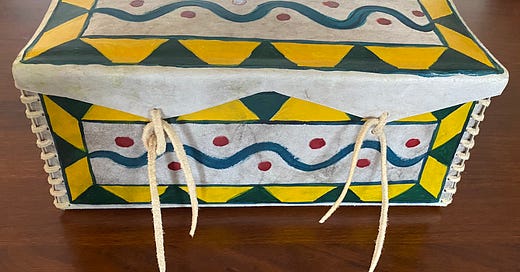My wife and I recently left the farm where my family had lived for more than 150 years. As a part of our ceremonial “unplugging” from that heritage, we invited my friend and his family from Flandreau, South Dakota, to come down and walk the Creek pasture with us.
Figure 1----Parfleche box designed and created by Avery Jones who is a keeper of traditional Dakota knowledge, a linguist and scholar, an artist and writer and a member of Wakpa Ipaksan Dakota Wicoti, Bend in the River Dakota Community (Flandreau Santee Sioux Tribe).
Avery brought a gift that commemorates that day. The parfleche box which he created has images tied specifically to our pasture along Kanaranzi Creek: the yellow triangles represent the sun beams coming down and the green triangles are the grass growing upward. The wave blue line is the meandering Creek channel and the red dots are the circular vegetation patterns that we’ve been studying all along the floodplain. Those circles appear to have cultural significance and I’ll tell you more about that in a later post.
Later when Avery and I stood alone on the hill west of our house, I asked him to say a blessing for the Land and our whole process of leaving. He kindly complied, but more than that he inspired the naming of the place that will be the focus of this Newsletter: Land at the Edge of the Sky. Here’s the story of how that happened….
Earlier this summer, my granddaughter and I went to an exhibition titled “Dakota Modern: the Art of Oscar Howe”. That exhibition has now closed and so has another at the University of South Dakota that featured the work of his students. But, here’s a link that describes the USD exhibition: https://www.usd.edu/academics/colleges-and-schools/college-of-fine-arts/south-dakotan-fine-arts/university-art-galleries-to-celebrate-oscar-howe-with-legacy-exhibition
On the way back home, we stopped to see Avery. This was the first time that my granddaughter had met Avery and he and I were reminiscing about that time we shared on the hill back on the Farm. He said, “That was a day!” and then went on to explain how the sky looked so open, high and wide out over the broad landscape.
The homelands for the Dakota people were originally the forests and lakes of glaciated Minnesota. And, although the Dakota have been displaced into urban settings and to areas west of the homeland, they still have a genetic memory of that country. Avery was more familiar with wooded stream valleys and the wide-open prairie was a surprising contrast.
I knew exactly what he meant. During my career as a geologist, I spent most of the summer months doing field work out under the big sky dome in the western Dakotas and eastern Montana. I enjoyed that experience. In contrast, I remember a traumatic time when I first started teaching. I could not see all of the fieldtrip students scattered through the underbrush in the woods in northeastern Minnesota and I panicked. They were all pretty casual about being in the forest, but it scared the Hell out of me!
When we moved back to the family farm about twenty-five years ago, I’m afraid that I took the great views of the high sky pretty much for granted. I enjoyed the panoramas of approaching thunderstorms that we had from our porch, but I wasn’t truly grateful enough. Now that we’ve moved away, I’ve got a different perspective.
We were living in Land at the Edge of the Sky, but I didn’t fully appreciate what that meant until we moved. And, until Avery’s comments helped me to really see the Sky and the Land.
Avery and I have worked together on several projects that involved the Dakota names for streams and landmarks in this general area. In fact, he’s currently looking into how the phrase Land at the Edge of the Sky might translate into Dakota. However, over the past several years he’s done a lot more; he has shared resources, insights, and personal contacts that have changed my life and my perspectives on the Land.
Acknowledgement: Avery Jones has given permission to use his name in this story. He’s a naturally humble guy and I’m grateful to have him as my friend.




